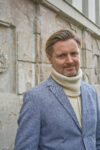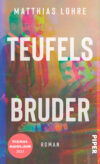At 21, Thomas Mann had no degree, no direction, and little more to his name than a few short stories that had gone mostly unnoticed. He was, in essence, a dropout—having abandoned a dull office apprenticeship—when he followed his older brother Heinrich to Italy. What he brought back to Munich some 18 months later was astonishing: a thick and ever-growing manuscript, his first novel, sprawling across a thousand pages. BUDDENBROOKS would not only launch his career, it would earn him the Nobel.
What happened in between?
Two Souls, One Closet
This question has preoccupied me since I first became interested in the man behind the myth. Mann seemed to carry two opposing souls in his chest. On the one hand, he was exquisitely sensitive, prone to melancholia, deeply in need of emotional support. Few writers have captured psychic anguish with as much empathy or insight. On the other hand, he could be coolly detached—even toward those closest to him.
And then there was love: Mann found companionship and security with Katia, whom he married and with whom he fathered six children. But the intense yearning, the romantic ideal of emotional fusion—those he reserved for young men, often from a distance. He longed for transgression and feared it above all else.
These tensions spilled into a fraught rivalry with Heinrich, four years his senior, who lived—and wrote about—his heterosexuality openly. Thomas Mann suffered under the weight of repression, desire, and fear. And he did what great artists do: he turned it into art. But how did he learn to master that storm?
Return of the Repressed
My novel begins in 1953. The 77-year-old Mann returns to Italy one last time. What he confesses there reads like a scene from one of his own novels—yet, all signs suggest it truly happened.
He pays a visit to a Munich-born painter, Fabius von Gugel, who is living in Rome. They meet at Mann’s suite in the Hotel Excelsior. Gugel brings with him a series of drawings—bizarre, dreamlike illustrations of the Grimm brothers’ Cinderella, each accompanied by enigmatic captions. Mann studies them in silence, visibly moved. Then he speaks.
According to Gugel’s later account, which Mann’s biographer Peter de Mendelssohn would deem credible, Mann said something remarkable:
“He had to tell him, that the drawings reminded him very strongly of an experience of his own—a vision he once had as a young man.”
“A vision?” the painter asked.
“A vision, indeed.”
Gugel was certain that Thomas Mann had used that word deliberately and with emphasis—not hallucination, not dream-image, not figment of the imagination or fancy or anything of the sort, but specifically: vision.
It had happened in his youth, Mann said, during the summer weeks he spent in Palestrina with his brother. One sweltering afternoon, sitting on a black sofa in the stone hall, he had suddenly seen a stranger appear—someone he instantly knew was none other than the Devil himself.
Ghosts in the Manuscript
The encounter would find its literary double decades later in DOCTOR FAUSTUS. In that novel, the composer Adrian Leverkühn is reminded by the devil of the terms of their pact: he may achieve genius, but only at the cost of his soul—and he must not love.
The infamous "Devil Chapter" is set in the very same Palestrina inn where the Mann brothers once stayed.
Did Mann truly say this? This, from the famously aloof master of self-concealment? De Mendelssohn believed so. The moment, he wrote, was “without doubt authentic,” and took place “in late summer 1897, in the stone hall of Palestrina.”
The more I read by and about Thomas Mann, the more this strange moment made sense. Mann often insisted he did not invent his stories so much as discover them. Nearly everything in his fiction draws from lived experience—not only the family drama of BUDDENBROOKS, but also the aching beauty of DEATH IN VENICE, which followed a visit to the lagoon city.
Mann had a gift for elevating the incidental to the monumental. When Katia was recovering from tuberculosis in a Davos sanatorium in 1912, he spent just three weeks at her side. The result? THE MAGIC MOUNTAIN. That novel, too, features the devil—more prominently than many have realized. Literary scholar Michael Maar explored this in his dissertation, GEISTER UND KUNST (GHOSTS AND ART), and again in DAS BLAUBARTZIMMER (THE BLUEBEARD ROOM), tracing the demonic throughout Mann’s oeuvre.
Indeed, that Palestrina vision, which fills pages in DOCTOR FAUSTUS, first flickers into view decades earlier, in a single line of BUDDENBROOKS. Christian, the eccentric brother, asks the consul whether he has ever entered a twilight room and seen “a man on the sofa who nods at you—only he’s not there at all?” Mann wrote those words either while still in Italy or shortly after his return.
From that point on, his work is haunted by devilish figures—often described as disheveled men with red hair. They appear again in DEATH IN VENICE.
From Hot Mess to Nobel Prize
I am convinced: In the summer of 1897, in Palestrina, the aimless young “Tommy” was plunged into crisis by a question that would shape his life: how to reconcile his private longing with social propriety and artistic ambition. Something happened in that sweltering Italian hall that transformed him. There, he conceived the idea to turn his family’s story into a novel. There, he found his voice—his mask, his armor, his literary persona.
BUDDENBROOKS did more than make him famous. Perhaps, just perhaps, they saved his life.
About the author
Matthias Lohre (b. 1976) is a Berlin-based writer, journalist, and nonfiction author. After studying history and English and training as a journalist, he spent nine years as an editor at die tageszeitung and went on to write for publications such as Geo Epoche, P.M. History, and Zeit Geschichte.
He gained wider recognition with nonfiction works like DAS ERBE DER KRIEGSENKEL (2016) and DAS OPFER IST DER NEUE HELD (2019), which explore social and psychological undercurrents in contemporary life.
His debut novel DER KÜHNSTE PLAN SEIT MENSCHENGEDENKEN (2021) tells the story of the utopian Atlantropa project, while his second novel, TEUFELS BRUDER (2025), offers a fictional take on the Italian journey of Heinrich and Thomas Mann. Lohre is also a co-founder of PEN Berlin.
Image: © Denise Sterr

About the book
In TEUFELS BRUDER, Matthias Lohre offers a striking portrait of a pivotal Italian sojourn undertaken by brothers Heinrich and Thomas Mann in 1896. While Heinrich has already tasted early literary success, his 21-year-old sibling Thomas grapples with questions of artistic identity. Haunted by the premature death of their father and beset by ongoing financial woes, the brothers become locked in an intense rivalry—a reflection of their conflicting ambitions and fundamentally different visions of life.
At the novel’s core is Thomas’s encounter with a melancholic youth in Venice, an episode that deeply unsettles him and gradually exerts an irresistible pull on his imagination. What begins as a chance meeting soon blossoms into obsession, propelling Thomas on a journey both inward and outward—one that ultimately culminates in a haunting, transformative vision.
With narrative elegance and a finely tuned sense for historical detail, Lohre conjures the young Thomas Mann as a figure of sensitivity and self-doubt, restlessly searching for his place in the world. It is during this formative journey that Mann lays the foundation for his future literary triumphs. - More information


